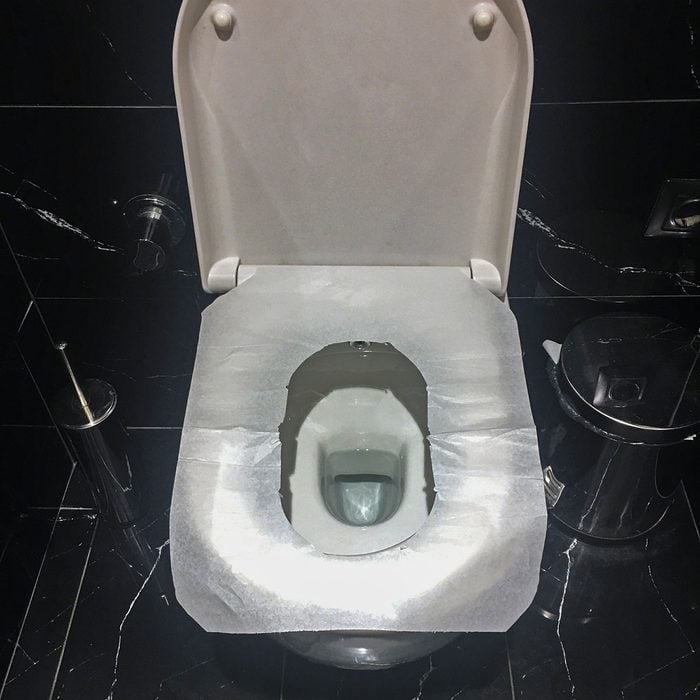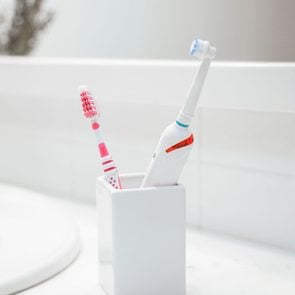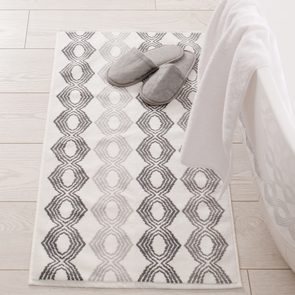The Right Way to Use a Toilet Seat Cover (Yep, You’ve Been Doing It Wrong)
Updated: Apr. 18, 2024

We asked public health experts how to use a toilet seat cover correctly—and whether it's actually necessary
The last time I needed to use a public restroom, I faced two unappealing options. I could either get in my leg workout for the day and squat over the toilet, or I could sit straight on the germ-filled seat I’d have to trust others knew how to clean. Thankfully, I lucked out and spotted toilet seat covers in my stall. The problem? Was I using those handy liners correctly to actually protect me from germs? It got me thinking that I could use some guidance on how to use toilet seat covers the right way.
For advice on all things toilet seat covers, I chatted with microbiologist Charles Gerba, PhD, and public health expert David Gimeno Ruiz de Porras, PhD. They gave the lowdown on why toilet seat covers exist, how useful they actually are at warding off germs—and the surprising method to apply one correctly.
Get Reader’s Digest’s Read Up newsletter for more cleaning, humor, travel, tech and fun facts all week long.
About the experts
Reviewed for accuracy by: Ann Russell, TikTok’s “cleaning auntie” and the author of How to Clean Everything. |
Do you need to use a toilet seat cover?
Using a toilet seat cover depends on your personal hygiene preferences, experts say. While many people think that the liners protect against germs, it turns out they’re not as effective as you might think. Toilet seat covers are porous, allowing microorganisms to pass through them and onto your skin, according to Gimeno Ruiz de Porras.
That said, you can rest assured that the risk of getting sick from sitting on a public toilet seat is quite low. Gimeno Ruiz de Porras notes that most public toilet seats are typically cleaned more frequently than other parts of the bathroom, like door handles and faucets. Public restroom cleaning schedules mean they’re also likely to be cleaned more often than you clean your toilet at home.
In addition, toilet seats contain fewer bacteria than many other items we touch throughout the day, including smartphones, according to a 2020 study published in the Journal of Urology. Gerba’s research backs this up. “In our studies, we found more fecal bacteria on cutting boards in the home kitchen (due to raw meat products and cleaning sponges) than toilet seats,” he says.
You shouldn’t be deterred if you want to use a toilet seat cover, though. Both experts recognize that learning how to use a toilet seat cover makes people feel safer when using public restrooms. Gimeno Ruiz de Porras recommends using one if the toilet seat looks dirty, while Gerba advises using one if you have any open wounds or cuts on your legs or bottom that could become infected.
How to use a toilet seat cover
@.andoeni Super random but learning this changed the game for me hahaha i went years using the toilet seat cover wrong 😂 #lifehack #toiletseatcover ♬ original sound – a n d o e n i
In order to get the most germ protection a toilet seat cover can provide, you need to use it correctly. Follow these steps when placing the paper liner on the toilet seat:
- Pull a toilet seat cover from the holder.
- Tear off the small attachments holding the flap on each side of the liner.
- Place the liner on top of the toilet seat, with the flap hanging into the bowl from the front of the toilet, not the back. That way, the liner will cover the entire seat.
- When you finish using the bathroom, simply flush the toilet to dispose of the cover. Since the flap is already in the water, the entire liner will be pulled into the toilet with the flush.
FAQs
What is the point of a toilet seat cover?
It’s unlikely that you will contract a disease or illness from a toilet seat, but toilet seat covers provide peace of mind to anyone who feels queasy about using a public restroom. Sound relatable? You’re in good company; in the 2020 Journal of Urology study, more than a quarter of women said they squatted when using a public restroom if toilet liners weren’t available. That’s why many public bathrooms still offer those handy liners, so that people feel a little bit cleaner when using the toilet.
Why do toilet seat covers have a flap?
Simply put, the flap on a toilet seat cover exists so that it can fall in the water at the front of the toilet and be pulled down when you flush.
Are you supposed to flush toilet seat covers?
Toilet seat covers are designed to be flushable, according to Gimeno Ruiz de Porras. But keep in mind that “just because products are labeled ‘flushable’ does not mean they are safe for your drain system,” he says. Older sewer systems and systems with septic tanks aren’t designed to handle any products but toilet paper, and that includes toilet seat covers and feminine products. In that case, you should simply place them in a trash can.
Why trust us
At Reader’s Digest, we’re committed to producing high-quality content by writers with expertise and experience in their field in consultation with relevant, qualified experts. For this piece, Brooke Nelson tapped her experience as a longtime writer and reporter. Then cleaning expert Ann Russell, author of How to Clean Everything, gave it a rigorous review to ensure that all information is accurate and offers the best possible advice to readers. For this piece, we relied on reputable primary sources, including cleaning and health experts and reputable government agencies. We verified all facts and data and backed them with credible sourcing, and we will revisit them over time to ensure they remain accurate and up to date. Read more about our team, our contributors and our editorial policies.
Sources:
- Charles Gerba, PhD, professor of microbiology and public health at the University of Arizona; email interview, Dec. 21, 2023.
- David Gimeno Ruiz de Porras, PhD, chair of the department of environmental and occupational health sciences at the University of Texas School of Public Health San Antonio; email interview, Dec. 20, 2023.
- Journal of Urology: “Women’s perceptions of public restrooms and the relationships with toileting behaviors and bladder symptoms: a cross-sectional study”



